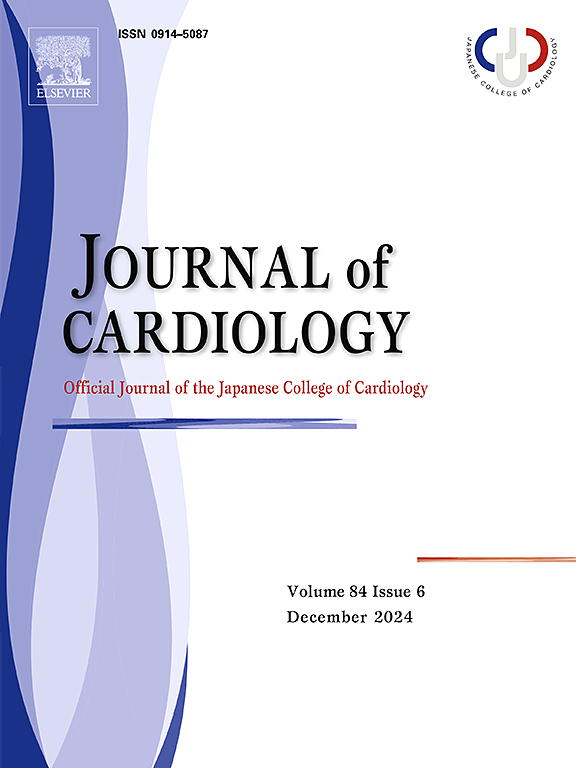经导管主动脉瓣植入术后谵妄严重程度与预后的关系。
IF 2.5
3区 医学
Q2 CARDIAC & CARDIOVASCULAR SYSTEMS
引用次数: 0
摘要
背景:经导管主动脉瓣植入术(TAVI)后谵妄与患者预后相关。然而,亚综合征性谵妄的预后影响是不确定的,它被描述为谵妄和正常认知之间的中间阶段。本研究旨在探讨谵妄严重程度对TAVI患者预后的影响。方法和结果:我们使用重症谵妄筛查清单(ICDSC)对在小仓纪念医院接受TAVI的1617例连续患者的谵妄状态进行前瞻性评估。患者分为以下三组:no-delirium [ICDSC得分0 n = 1035(64.0 %)],亚综合征谵妄(ICDSC 1 - 3 n = 348(21.5 %)],和谵妄(ICDSC 4 - 8人,n = 234(14.5 %)]组。较差的谵妄状态与老年、较高的虚弱程度和较高的合并症患病率相关,包括心房颤动、痴呆和外周动脉疾病。在手术后2 年,临床随访率为92.6 %,亚综合征性谵妄的累积全因死亡率明显更高(21.8% %)(p )结论:超过三分之一的TAVI患者出现谵妄,包括谵妄和亚综合征性谵妄,并与死亡率增加相关。本文章由计算机程序翻译,如有差异,请以英文原文为准。

Association between delirium severity and prognosis following Transcatheter aortic valve implantation
Background
Delirium is associated with patient prognosis after transcatheter aortic valve implantation (TAVI). However, the prognostic impact of subsyndromal delirium, described as an intermediate stage between delirium and normal cognition, is uncertain. The present study aimed to investigate the prognostic impact of delirium severity in patients undergoing TAVI.
Methods and results
We prospectively assessed the delirium status of 1617 consecutive patients who underwent TAVI at Kokura Memorial Hospital using the Intensive Care Delirium Screening Checklist (ICDSC). The patients were divided into the following three groups: no-delirium [ICDSC score 0, n = 1035 (64.0 %)], subsyndromal delirium [ICDSC 1–3, n = 348 (21.5 %)], and delirium [ICDSC 4–8, n = 234 (14.5 %)] groups. A worse delirium status was associated with older age, higher degree of frailty, and higher prevalence of comorbidities, including atrial fibrillation, dementia, and peripheral arterial disease. At 2 years post-procedure with a clinical follow-up rate of 92.6 %, the cumulative all-cause mortality rate was significantly higher in the subsyndromal delirium (21.8 %) (p < 0.001) and delirium (29.1 %) (p < 0.001) groups than in the no-delirium group (11.9 %). After adjusting for pre- and post-procedural confounders, subsyndromal delirium and delirium were associated with an increased mortality risk [adjusted hazard ratio (HR) for subsyndromal delirium, 1.38; 95 % CI, 1.00–1.90; p = 0.049; adjusted HR for delirium, 1.61; 95 % CI, 1.15–2.17; p = 0.006].
Conclusions
Delirium conditions, including delirium and subsyndromal delirium, occurred in more than one-third of patients who had undergone TAVI and were associated with increased mortality.
求助全文
通过发布文献求助,成功后即可免费获取论文全文。
去求助
来源期刊

Journal of cardiology
CARDIAC & CARDIOVASCULAR SYSTEMS-
CiteScore
4.90
自引率
8.00%
发文量
202
审稿时长
29 days
期刊介绍:
The official journal of the Japanese College of Cardiology is an international, English language, peer-reviewed journal publishing the latest findings in cardiovascular medicine. Journal of Cardiology (JC) aims to publish the highest-quality material covering original basic and clinical research on all aspects of cardiovascular disease. Topics covered include ischemic heart disease, cardiomyopathy, valvular heart disease, vascular disease, hypertension, arrhythmia, congenital heart disease, pharmacological and non-pharmacological treatment, new diagnostic techniques, and cardiovascular imaging. JC also publishes a selection of review articles, clinical trials, short communications, and important messages and letters to the editor.
 求助内容:
求助内容: 应助结果提醒方式:
应助结果提醒方式:


